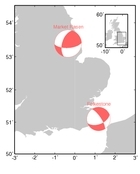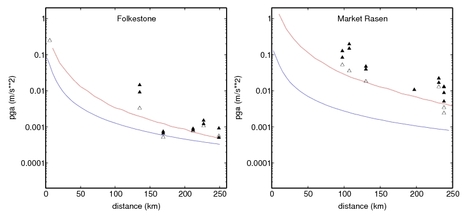Ground Motion Differences between the Folkestone and Market Rasen Earthquakes
Seismic hazard studies produce estimates of ground acceleration, but in areas of low seismicity, like the UK, there are few measurements of strong ground motion from earthquakes. The recent Market Rasen and Folkestone earthquakes were the largest and most damaging earthquakes to strike the UK in many years. However, the stress drop, the change in stress across a fault before and after an earthquake, was ten times larger for Market Rasen than for Folkestone. The high stress drop of the Market Rasen earthquake resulted in a much higher ground acceleration than predicted by empirical ground motion relationships commonly used in seismic hazard studies. This suggests that seismic hazard models may be improved by including estimates of stress drop.
Details
Both earthquakes were strongly felt and caused some nonstructural damage. The earthquakes occurred at significantly different depths, the Folkestone earthquake at 5 km and the Market Rasen earthquake at 20 km. We found stress drops of 30 bar and 344 bar for the Folkestone and Market Rasen mainshocks, respectively. This is a significant difference considering the earthquakes are only 275 km apart and both are of intraplate origin. We applied a stochastic ground-motion modelling technique and used the stress drop and seismic moment to compute vertical component peak ground acceleration. The modelled ground motions are consistent with the observations. We also computed vertical peak ground acceleration for a hypothetical Mw 6.0 high stress-drop (200 bar) earthquake and found that it would be 4.6 m/sec2 at 20 km hypocentral distance.

- A Comparison of the Folkestone and Market Rasen Earthquakes
- Revised Seismic Hazard Maps for the UK
- Seismogenesis and State of Stress in the UK
- Monitoring Volcanic Eruptions Using Interferometry
- Particular events
- Are yesterday's earthquakes tomorrow's disasters?
- Creating 'virtual seismometers' deep inside the Earth
- Fault line living
- Is earthquake activity related to the Moon or Sun?
- Is earthquake activity increasing?

- Ottemoller, L. and Sargeant, S., 2010. Bull. Seism. Soc. Am., Vol. 100, No. 4, 1823-1829
- Ottemoller et al, 2009. Bull. Seism. Soc. Am., Vol. 99, No. 3, 1853-1867
- Sargeant et al, 2008. Seismological Research Letters, Vol. 79, No. 5, 672-687
- SECED Report on Folkestone Earthquake
- Boore, 1983. Bull. Seism. Soc. Am., Vol. 73, 1865-1894


